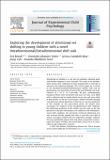Exploring the development of attentional set shifting in young children with a novel Intradimensional/Extradimensional shift task
Abstract
Attentional set shifting is a core part of cognition, allowing quick and flexible adaption to new demands. The study of its development during early childhood has been hampered by a shortage of measures not requiring language. This article argues for a revival of the Intradimensional/Extradimensional (ID/ED) shift task by presenting a new nonverbal version of the task (Shifting Tray task). Children (N = 95 3- to 5-year-olds; 49 girls; predominantly European White) were presented with pairs of trays, each filled with a substrate and an upside-down cup on top, and were asked to find stickers. In the pre-switch phase, children learned (through trial and error) which dimension (substrate or cup) was predictive of the rewards. In the post-switch phase, all stimuli were exchanged. For children in the intradimensional shift condition, the dimension predictive of the sticker was the same as the one predictive in the pre-switch phase. For children in the extradimensional shift condition, the previously irrelevant dimension was now relevant. Results showed that most 3-year-olds were able to switch, and older children did not outperform younger children. The easy and flexible nature of the task allows researchers to investigate the impact of labels and instructions and to use it in cross-cultural and comparative research.
Citation
Reindl , E , Völter , C J , Campbell-May , J , Call , J & Seed , A M 2022 , ' Exploring the development of attentional set shifting in young children with a novel Intradimensional/Extradimensional shift task ' , Journal of Experimental Child Psychology , vol. 221 , 105428 . https://doi.org/10.1016/j.jecp.2022.105428
Publication
Journal of Experimental Child Psychology
Status
Peer reviewed
ISSN
0022-0965Type
Journal article
Description
The research of A.M.S. was supported by an “INQMINDS” European Research Council (ERC) Starting Grant (SEP-210159400).Collections
Items in the St Andrews Research Repository are protected by copyright, with all rights reserved, unless otherwise indicated.
Related items
Showing items related by title, author, creator and subject.
-
The shifting shelf task : a new, non-verbal measure for attentional set shifting
Reindl, Eva; Voelter, Christoph; Civelek, Zeynep; Duncan, Lisa Frances; Lugosi, Zsuzsa; Felsche, Elisa; Herrmann, Ester; Call, Josep; Seed, Amanda M. (2023-01-25) - Journal articleAttentional set shifting is a core ingredient of cognition, allowing for fast adaptation to changes in the environment. How this skill compares between humans and other primates is not well known. We examined performance ... -
Neural mechanisms of executive function : the role of the pedunculopontine tegmental nucleus and medial prefrontal cortex in delayed spatial win-shift behaviour in the rat
Taylor, Claire L. (University of St Andrews, 2002) - ThesisThe pedunculopontine tegmental nucleus (PPTg) has been argued to be involved in mediating neural processing relating to executive functions (Winn, 1998). Since it shares connections with fronto-striatal circuitry this ... -
More religious yet still secular? The shifting relationship between the secular and the religious in Syria
Khatib, Line (Centre for Syrian Studies, School of International Relations, University of St Andrews, 2016-02-11) - Journal articleIn More Religious, Yet Still Secular? The Shifting Relationship Between the Secular and the Religious in Syria, Line Khatib takes us on a more recent journey than that of Aldoughli’s narrative, and explores how secularism ...

